What led up to the Declaration of Independence? Yes, it certified America as being independent of Britain, but influential thinkers like John Adams — who was initially considered a radical for wanting complete separation — didn’t become mainstream until Thomas Paine’s “Common Sense” publication. This piece will explore the development of how the idea of full independence came to be.
King George’s mercilessness shaped later public opinion
At the very beginning of the Revolution, most colonists didn’t want independence from Britain, but reconciliation. Still feeling loyal to King George III and Britain but opposed to the extreme taxes and unfair laws imposed upon them, they wanted to make a deal with the king and return as British citizens.
John Adams was one of the first individuals who called for full independence — to make America its own nation and government. However, he and others who thought like him were unable to change the majority opinions of the colonists — for a time.
Public sentiment started to shift as King George III ramped up his efforts to eliminate the rebels. When news of his intentions reached the colonies, the ideals of Adams and other “radicals” rapidly became more popular.
However, even this wasn’t the turning point. Many conservatives still held on to the idea that reconciliation was possible. The notion that America should be fully independent only became cemented in the majority of colonists’ minds after Thomas Paine published a pamphlet titled “Common Sense.”
 “The appearance of the U.S. Department of Defense (DoD) visual information does not imply or constitute DoD endorsement.”
“The appearance of the U.S. Department of Defense (DoD) visual information does not imply or constitute DoD endorsement.”“Common Sense” and its influence
Thomas Paine’s 47-page “Common Sense” pamphlet was published in Philadelphia in January 1776. Within it, Paine illustrated a passionate ideal for American exceptionalism. Believing America represented a “promise” that could only be achieved through total independence and separation between Americans and Britains, he laid out his case that this was the only natural option.
“Common Sense” was immensely popular. Its ideas influenced a massive number of colonists and galvanized support for the Revolution. By the time the Revolutionary War ended, it had sold about 500,000 copies — an astronomical number for its time. The publication would even influence some parts of the U.S. Constitution and the Bill of Rights.
Jumping back to 1776, the Continental Congress soon adopted Paine’s idea of separating from Britain and forging a new nation. On July 2, about seven months after Paine’s publication was released, Congress held a vote on declaring independence. The Declaration of Independence was ratified on the 4th and America became its own nation.
Thomas Paine’s humble beginnings belied his impact on history
Born in Thetford, England in 1737, Thomas Paine had little formal education and was plagued by a series of job failures and tragedies.
His luck would pick up when he met Benjamin Franklin in the spring of 1774. Offering Paine a letter of introduction so he could start a new life there, Franklin suggested he move to the American colonies. In November, Paine would arrive in Philadelphia and soon began editing the Pennsylvania Magazine. It was here he wrote a series of pieces following his ideals.
While nothing he wrote came anywhere near the influence of “Common Sense,” Paine wrote other essays and pamphlets. These included “The Age of Reason” and “Rights of Man,” which discussed religion’s role in society and a defense of the French Revolution, respectively. Another example proving he was well ahead of his time is “African Slavery in America,” a piece condemning the slave trade.
Celebrate the history of America’s independence this July 4th
America may never have been its own nation without the ideals and philosophies of people such as John Adams and Thomas Paine. This Independence Day, be grateful that these immensely influential and historically invaluable individuals helped bring you the liberty you have today.
If you’re a servicemember, veteran, dependent or any other eligible type of passenger, you may qualify for free accommodations on Space-A flights if a vacancy is available.
What is a Space-A flight?
Space-A stands for space-available flight and is also referred to as military hopping. If a Department of Defense (DoD) aircraft has vacancies when traveling between air bases, eligible persons may fill these seats at no charge, according to the John S. McCain National Defense Authorization Act. The purpose of Space-A is to give certain types of people the freedom to travel on flights that have vacancies.
Space-A flights can be on commercial airplanes, but they might also be on fuel tankers or cargo aircraft.
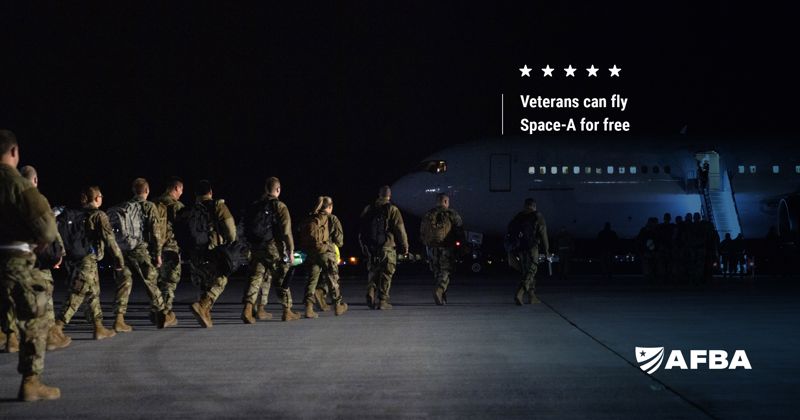 “The appearance of the U.S. Department of Defense (DoD) visual information does not imply or constitute DoD endorsement.”
“The appearance of the U.S. Department of Defense (DoD) visual information does not imply or constitute DoD endorsement.”The different categories of travelers
Depending on who you are and the reason for your travel, you’re placed in one of six categories. When Space-A considers who gets priority when someone requests to fill a vacancy, the lower categories get picked first. Here are the different categories and what they might include:
Category 1: Emergency leave travel
The emphasis here is on the word “emergency.” People who might qualify for this category include DoD civilian employees who are stationed overseas or full-time American Red Cross employees serving in a military capacity.
Category 2: Accompanied environmental and morale leave (EML)
This might include DoD Dependent School (DoDDS) teachers on vacation or sponsors traveling for EML purposes.
Category 3: Ordinary leave, house hunting TDY
Those on ordinary leave or military members who are house hunting (following PCS orders) generally qualify for this rank.
Category 4: Unaccompanied dependents on EML
Family members on EML are in this tier. This also encompasses DoDDS teachers and their family members.
Category 5: Permissive TDY, students, dependents, post-deployment/mobilization respite absence
If their sponsor is stationed overseas or in Alaska or Hawaii, students fall into this group.
Category 6: Retirees, dependents, reservists and disabled veterans
This category would apply to these types of flyers on vacation, for example.
How to sign up for Space-A flights
Signing up for a Space-A flight is very different from booking a seat on a commercial aircraft. You won’t be using traditional airports or booking accommodation at all; instead, you’ll communicate with an Air Mobility Command (AMC) Passenger Terminal to reserve a spot.
These are instructions to keep in mind, according to AMC. More information can be found on their website.
- Ensure your eligibility. There are six categories of travel that determine your eligibility for Space-A, with lower categories getting higher priority. This includes emergency leave, unfunded travel, and accompanied or unaccompanied environmental and morale leave (EML). Which category you fall into depends on the reason behind your travel and your duty status.
- Check which locations are available. Review your closest AMC Passenger Terminal through their social media page or website.
- Make sure your documents are in order. Look at which travel documents you need to prepare before your flight. This includes your passport (with visas, if applicable).
- Register at an AMC Passenger Terminal.
- Look at flight schedules. There is a 72-hour flight schedule on the American Forces Public Information Management System (AFPIMS) web page.
- Check-in at the terminal counter. Familiarize yourself with any newly updated flight information and declare that you are present. If everything is in order, the terminal will give you a Space-A call when they’re ready for you to board.
Roam the skies for free with Space-A flights
While not everyone is eligible to ride on a Space-A flight under all circumstances, as long as you meet the basic requirements, you can take advantage of this perk. For more information, contact your nearest AMC passenger terminal.
21 years ago, the tragic attack on the World Trade Center (WTC) and the Pentagon left Americans stunned and shocked. On its anniversary, citizens take the day to commemorate heroes who acted in bravery and those who lost their lives in the senseless act of terrorism. Today, we want to share some facts to consider on this day of remembrance.
1. The World Trade Center
Before the attacks, the WTC hosted many employees who went to work every weekday. The Twin Towers normally had 50,000 workers and 40,000 additional visitors. During the attacks, over 3,000 people passed away, many of whom were first responders who arrived on the scene to save civilian lives.
2. Dangerous cleanup
The horrible terrorist attacks cost thousands of lives and resulted in dangerous wreckage that trapped even more people. The rescue crews were able to save 18 individuals from the ruins, which, by expert estimations, weighed 1.8 million pounds. The recovery process lasted nine months and ended on May 30, 2002.
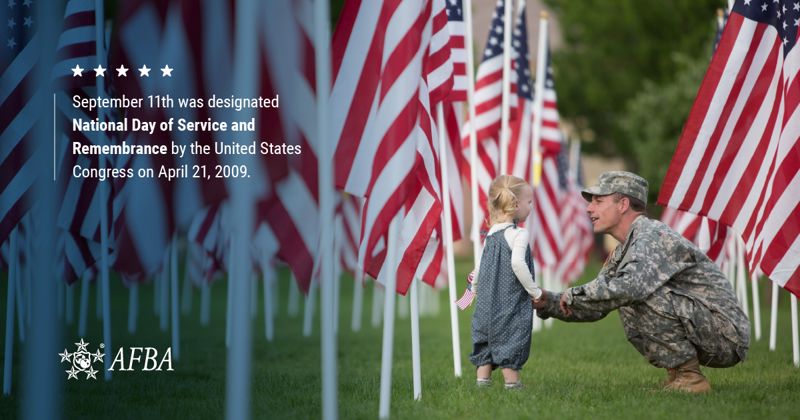
3. Terrible loss of life
Most people know the attacks on the WTC resulted in the tragic loss of life, but the act of terrorism marked an awful day for another reason as well. It was the largest loss of life by a foreign attack on American soil.
4. The catalyst of change
The horrific event changed the ways that Americans saw security and safety. In fact, in 2001, 50% of Americans reported to Pew Research that they wanted to see America change in a serious way. Here are some of the biggest policy changes implemented after the attacks:
- Created new institutions like the Department of Homeland Security, Directorate of National Intelligence, and National Counterterrorism Center.
- Increased resources for intelligence programs in the US.
- Increased air travel security.
- Urged leaders to increase counterterrorism partnerships across the globe.
After the attacks, American leaders took a more serious approach to homeland security and preventing terrorism on American soil.
5. Impact on public opinion
The atrocious event shocked American citizens and completely altered public perception and opinion. The impacts of this can be seen in the increased patriotic sentiment across the country. Pew Research found that 79% of adults "displayed an American flag" in 2001. Political divides shrunk as people shared a sense of loss and tragedy, with about 60% of adults reporting that they trusted in the federal government in October of 2001. This is a high that was unseen in the previous 30 years and has not been met since.
The events of 9/11 changed the course of American history and deserve to be remembered with respect. Each year the attacks grow further away, but the memory of the day will not be forgotten. Take the time for a brief moment of respectful silence or learn more about the events to honor those who were lost.
The U.S. military is constantly evaluating its strategy for security, both in the homeland and abroad. Each state in the U.S offers its own benefits to the military, either based on location, climate, or population. The northernmost part of the United States, Alaska, is no exception and provides its own unique advantages to the military. Most recently, as threats from China and Russia mount, Alaska has become a very important strategic asset to the U.S. Military.
150 years of the U.S. military in Alaska
There are nine military bases across the 104 million acres that make up Alaska. This is by no means the most military bases in one state, but each base is strategically located to optimize the benefits.
Alaska has acted as a tactical boon for the U.S., even before it became a state. President Andrew Johnson obtained Alaska for the U.S. from Russia on October 18, 1867. The military actually managed the governance of the area until Alaska became an official state on January 3, 1959.
As of 2019, there were 21,407 active duty military personnel in Alaska. The Air Force has the largest presence, making up 38% of the active duty military population there.
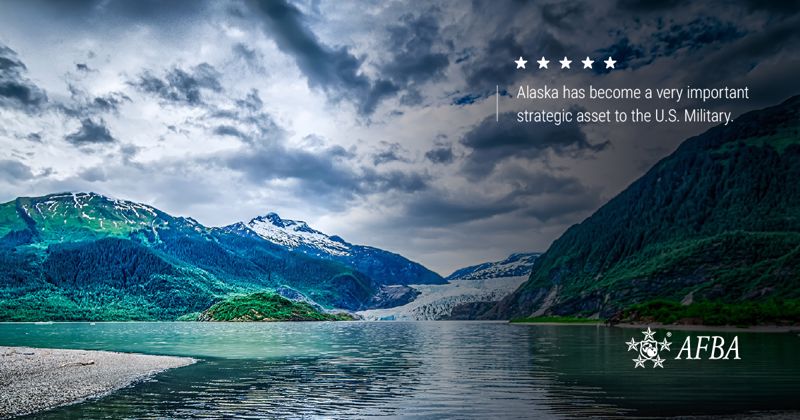 The appearance of U.S. Department of Defense (DoD) visual information does not imply or constitute DoD endorsement.
The appearance of U.S. Department of Defense (DoD) visual information does not imply or constitute DoD endorsement.Alaska as a strategic location
Alaska’s climate is harsh and unforgiving, with temperatures that sink below 0° F and a climate that supports little vegetation. However, Alaska’s location makes it ideal for military occupation. When Russia sold Alaska to the United States, Japan was occupying several of the Alaskan islands because of the area’s prime location.
The state’s geography allows bases easy simultaneous access to Arctic and Indo-pacific regions. This is a unique advantage for our country because the military can easily traverse both the Pacific Ocean to the south and the Arctic Ocean to the north.
Defense Secretary Lloyd Austin said in a July 2021 press release that the U.S. has increased its defenses in Alaska as a result of mounting pressures from Russia and China. It is the U.S.’s closest reliable landmass to those international security threats.
Protection against homeland security threats
Defense leaders like Austin consider Alaska a key asset in the military’s ability to make its power known in both the Arctic and Indo-pacific regions.
Protective bases in Alaska increase in importance as threats from the Arctic and Asian regions continue to build. Russia dominates most of the Arctic Circle, probably due to the fact that 25% of its GDP comes from natural resources found in the Arctic Circle, according to the U.S. Department of Defense (DoD). But Russia isn’t the only country/government bolstering its arctic activity.
China is also working towards increasing its presence in the Arctic, but it wields a significant amount of influence in Asia. According to a press release from the DoD, China is likely interested in accessing the vast and generally untapped natural resources in the Arctic which include “90 billion barrels of oil and an estimated trillion dollars’ worth of rare earth metals.” These resources are more accessible than ever before, as melting layers of permafrost expose them.
How the U.S. competes
Training has always been a key component of every branch of the military’s success, but this is especially true in Alaska where there is plenty of space for military facilities. A major one is the Joint Pacific Alaska Range Complex, where the training of several branches converge. The facility includes 65,000 miles of airspace, 490 miles of land space with 1.5 million acres of maneuver land and 42,000 nautical miles of sea and airspace in the Gulf of Alaska.
Training is only a part of the military’s efforts to prepare active duty service members and is only a part of the DoD’s homeland security strategy. Among many other things, the U.S. plans to utilize the Alaska-based Air Force units. Defense Secretary Austin cites fifth-generation strike aircraft to integrate air and missile defense as notable examples of how Alaska is essential to the U.S. Military.
The terrorist attacks that occurred September 11, 2001 changed the world forever and on its anniversary, Americans take the time to remember the events of that tragic day. Officially, it is September 11 National Day of Service and Remembrance and is also known as Patriot Day. This is a chance to commemorate and remember those who were lost and survivors of the attack on the World Trade Center.
September 11, 2021 is the 20th anniversary of the attacks. This Remembrance Day, there will be special commemorative events and individuals across the nation will pause for a moment of silence to reflect. The day is a chance to remember the attack that aimed to break America but instead brought people together and made the country stronger.
The 9/11 Memorial & Museum remembers
The 9/11 Memorial Museum is a commemorative exhibit that pays tribute to the event through education and remembrance. According to 911memorial.org, 2,977 people passed away as a result and countless more were injured or impacted in some irreversible way. The anniversary of the tragedy that was the 9/11 terrorist attacks is filled with emotion and gives an opportunity for solace.
The 9/11 Memorial and Museum will be taking special measures for the 20th Anniversary Commemoration. They will be hosting a reading of lost loved ones by family members where there will be six moments of silence. The number six is significant because it acknowledges “when each of the World Trade Center towers was struck and fell and the times corresponding to the attack on the Pentagon and the crash of Flight 93.”
The first moment of silence will be observed at 8:46 a.m. on September 11, 2021 and the memorial will encourage churches to toll their bell as sign of respect and solidarity. Family members who lost someone during 9/11 are allowed free entrance to the ceremony.
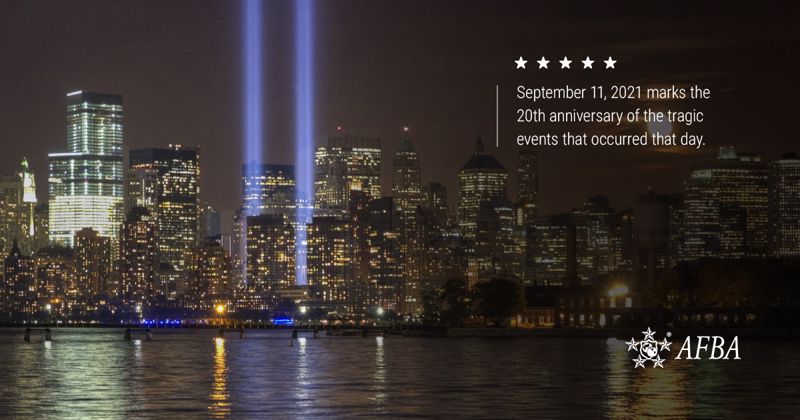 The appearance of U.S. Department of Defense (DoD) visual information does not imply or constitute DoD endorsement.
The appearance of U.S. Department of Defense (DoD) visual information does not imply or constitute DoD endorsement.The FBI and DoD nods to the holiday
Because 2021 marks two decades since the terrorist attacks on the World Trade Centers, the FBI took the time to commemorate how the events changed the bureau. In fact, the FBI director makes it a special requirement that all new agents take the time to visit the memorial and remember the contributions that previous agents made in the focus on terrorism.
9/11 changed the way that the military and all branches of the armed forces operate. It truly changed the course of military action forever. The Department of Defense acknowledges its impact and those who gave their lives in pursuit of freedom with a collection of stories from people whose lives were impacted by that terrible day 20 years ago.
Volunteer opportunities
Whether you were directly impacted by the terrorist attack, every American’s life was touched in some way. If you are unsure how to make a difference, give back, or commemorate the 20th anniversary, here are a few meaningful and easy ways to offer service to our country.
Americorps
Volunteer organization Americorps notes that 9/11 is also National Day of Service, and there is no better way to remember those who lost their lives protecting our nation than to give back to the country they were protecting. Americorps has a great search engine where you can find opportunities that are connected to 9/11.
Take the time for a brief moment of respectful silence, donate time, or commemorate the 20th anniversary of 9/11 in your own way.
With over 2.91 million service members and civilians working in the U.S. Department of Defense (DoD), it can be hard to imagine a time without it. However, it was only established in 1949. August 10, 2021 marks 72 years of the modern version of this federal department officially overseeing the U.S. armed forces (previously known as the U.S. War Department). Over the past seven decades, the department has gone through many changes, but it has always stayed true to its motto of “duty, integrity, ethics, honor, courage and loyalty.”
A brief history of the DoD
Even before the 1940s, the federal government managed the U.S. armed forces. The earliest iteration of the DoD was established by the first congress in 1789 and was called the U.S. War Department. It managed the Army and the Navy, which were the only branches of the U.S. military at the time. However, as the country evolved, so did military operations.
The first reform
In the interim between the War of 1812 and the Civil War, legislators decided it was time to make some serious renovations to the management of the nation’s defense. The change entailed incorporating bureaus, advisors and a Secretary of War who directed the department.
It seemed this change came at an ideal time, because the Civil War required strict management of wartime activities. During the Civil War, the U.S. War Department began recruiting volunteers and members of the Army, bringing upwards of 2 million troops under the DoD’s purview.
The results of the Civil War shaped the U.S. War Department forever. In the mid to late 1860s, the department was given the responsibility of managing formerly enslaved people and wartime refugees. During reconstruction, the new southern American governments needed as much support as they could obtain and the U.S. War Department was tasked with aiding them.
The National Security Act of 1947
Following World War ll, The National Security Act was passed into law with the goal of modernizing the military and intelligence agencies. As a result of the act, the National Military Establishment (NME) was created as the country’s first unified military command under the control of one person: the Secretary of Defense. This is the same act that created the Central Intelligence Agency (CIA), the National Security Council and the United States Air Force.
A noteworthy change was made as a result of the National Security Act: The NME was renamed the “Department of Defense.” This was due to an amendment to the 1949 act and three cabinet-level military departments were absorbed into a singular department.
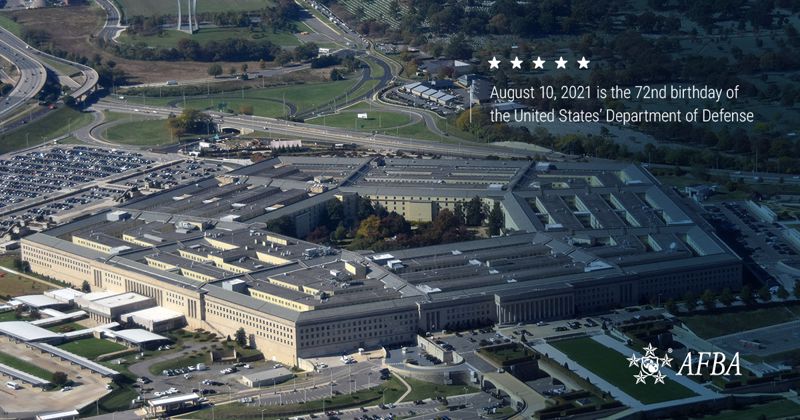 The DoD celebrates 72 years of defending our nation.
The DoD celebrates 72 years of defending our nation.The modern DoD
Many adjustments to the department have been made since then, all in an effort to keep up with the shifting national and international security requirements. The Defense Reform Act of 1958 and the Goldwater-Nichols Act of 1986 both made key modifications to the DoD, mostly regarding the restructuring of the power dynamic.
Celebrating the DoD’s Birthday
Despite the fact that August 10 is not a national holiday, members of the department often take the time to recognize the holiday internally. Service members enjoy cake cutting ceremonies and take the time to look back on the rich history of the department.
This year, consider donating time or money to a service project that supports the military, or even just go out of your way to thank a member of the armed services.
You likely use online accounts and digital devices more times than you can count. But how many steps have you taken towards keeping your devices and data secure? If you answered "few to none," we're here to help during National Cybersecurity Awareness Month (NCSAM), which is held every October.
The theme this year is "Own IT. Secure IT. Protect IT." Beyond encouraging general awareness of digital threats, the theme urges users to take full ownership of their digital presence while taking steps to safeguard it against cyberattacks. Cybersecurity and Infrastructure Security Agency (CISA) and the National Cyber Security Alliance (NCSA) jointly lead the initiative.
In the past, we've shared a glossary of cybersecurity terms to help you differentiate between the good, the bad, and the ugly. This year, we're sharing a few simple actions you can take today to shore up your digital presence.
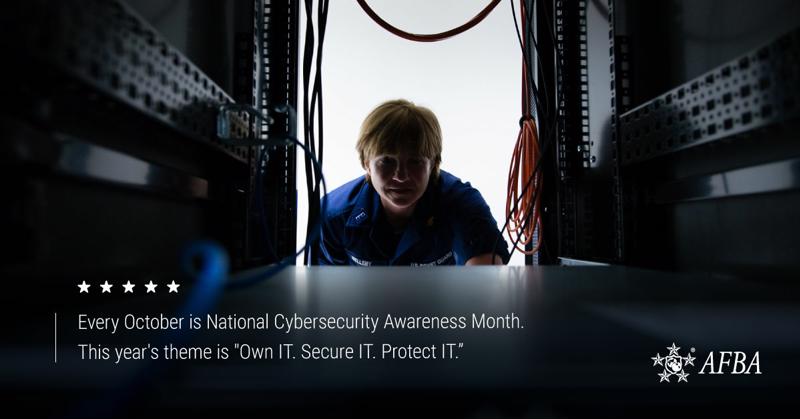
Swap out old passwords for new, complex passwords
One of this year's NCSAM mottos is, "If you connect, you must protect." This means you shouldn't use any device or account without first password-protecting it. It's especially important to follow this guidance when you're using accounts that contain sensitive information, such as email accounts and online banking services.
Take some time to switch out all of your old passwords for new, secure passphrases. To make them as long as you can, start with a movie title or catchy phrase rather than a single word. Then, mix up the phrase with special characters, numbers, and capital letters as well as unconventional spellings.
These days, email addresses often double as usernames. A 2015 study conducted by Dashlane revealed that the average email account was associated with 130 other accounts. For this reason, you should avoid recycling the same password over and over again. Create one password for each account. If one account becomes compromised, your others will remain secure.
Use a password manager to memorize your login credentials
Once you have a new series of unique, complex passwords, you'll have to store them somewhere. If you think a mental note or pen-and-paper password log is the safest place to keep your credentials, you're not alone. In fact, 84% of adults use only written lists or memory to keep track of passwords, according to a recent Pew Research Center study. Not surprisingly, the study also revealed that 64% of American adults have experienced at least one data breach that may have compromised sensitive personal information.
However, a 2017 survey conducted by LastPass found that respondents had an average of 191 passwords to manage — far too many to memorize. This strategy might have worked in the early days of the Internet, but it only invites cybersecurity breaches nowadays.
Instead, create your own digital keychain through a password manager. Such a system will be able to track as many accounts and passwords as you create. Even better, many can sync across multiple devices, so that if you create a new online account from your phone, you'll be automatically logged in when you visit the site from your laptop.
Some web browsers and devices offer free built-in password managers, or you can use third-party service to track your passwords. For an added layer of security, opt to use multifactor authentication (MFA) whenever possible. With MFA, you'll login using two credentials, such as a password and a unique security code that's automatically sent to you via text message.
Keep in mind that a password is the first line of defense against a cyberthreat. If you choose to use a digital keychain, make sure you password-protect all of your devices and lock them while they're not in use.
When a 35-day partial government shutdown hit the nation in the 2018-2019 winter, thousands of federal employees, contractors and others went without pay. Even the Coast Guard missed paychecks after more than a month political standstill, but kept working through the shutdown. This was notable because the Coast Guard was the only part of the nation's armed forces that went without pay during that stretch, as it is part of the Department of Homeland Security and not the Department of Defense, whose funding did not lapse.
While members of the Coast Guard did receive back pay, Congress has recently moved to remedy that oversight and prevent any future shutdowns from obstructing Coast Guard from being paid.
Bill passes House and Senate panels
The Coast Guard Reauthorization Act of 2019 is the latest edition in a regular series of legislation that makes appropriations and other updates to modernize and improve the service and how it operates. A feature of this reauthorization act is the stipulation that requires Coast Guard to be paid should any shutdowns materialize in the future, among other reforms. This was done through the inclusion of an amendment titled the "Coast Guard Pay Parity Act" that would ensure paychecks are sent despite any shutdown occurring.
The legislation is well on its way to passing through Congress, having cleared key panels in both the House and the Senate with bipartisan support. The House Transportation and Infrastructure Committee had passed the reauthorization act near the end of June. At that time, Committee Chair Rep. Peter DeFazio (D-OR) hailed it as crucial to protecting both the men and women of the Coast Guard and recognizing their sacrifice.
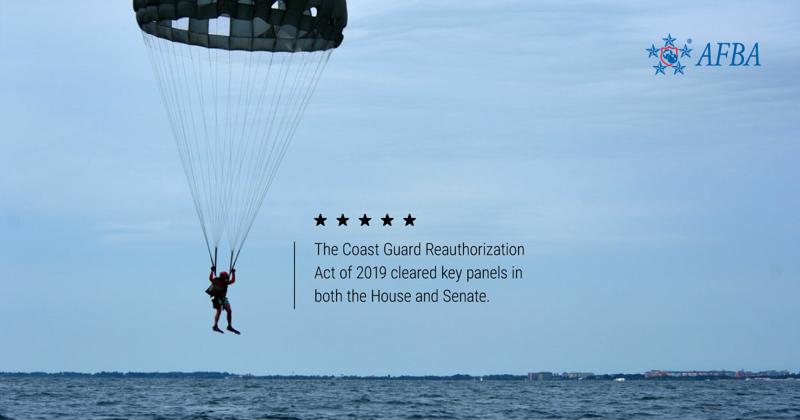
"This legislation ensures our Coasties can continue carrying out their important work to secure our waterways and keep our communities safe," DeFazio said. "In addition, I am proud to have added an amendment which guarantees that members of the Coast Guard are paid on time and in full, even in the event of another senseless government shutdown."
On July 31 the Senate Committee on Commerce, Science, and Transportation approved the Coast Guard Reauthorization Act of 2019.
"I'm honored to have led the effort on this year's Coast Guard reauthorization, supporting members of the fifth branch of our military who are far too often overlooked or forgotten," said Dan Sullivan (R-AK). "With this legislation, we will ensure that Coast Guardsmen never again are risking their lives and serving without pay – as they were during the partial government shutdown earlier this year."
The full House and Senate will need to vote on and pass the act before it can be sent to the president and signed.
42,000 went without pay last time
The unique circumstances of the Coast Guard being part of the Department of Homeland Security — instead of Defense, like the other four branches of the military — led to it being affected by the shutdown. During those 35 days, 42,000 missed a paycheck, including active duty members, reservists and retirees, according to NBC news. The lapse negatively affected thousands who had families to support and payments to make, like those for mortgage or credit cards. The Coast Guard even provided its members with a financial management tip list.
The legislation is hugely important not just for members themselves, but for national security and the efficacy of the Coast Guard. According to a report from The Wall Street Journal, the Coast Guard took time to recover after the shutdown delayed crucial maintenance and supply replenishment.
Mark Esper was recently confirmed as the new Secretary of Defense. His swearing in marked the end of seven months in which the department went without a confirmed leader, the longest such period in its history.
A veteran of the Army and the defense industry, Esper said he aims to tackle leadership vacancies within the department as America and the global community confront various modern threats.
West Point grad, Screaming Eagle
Esper was born in Uniontown, Pennsylvania, in 1964, and was a 1986 graduate of the United States Military Academy, receiving a commission in the infantry. According to his DoD biography, Esper completed Ranger and Pathfinder training, serving in the 1990-91 Gulf War with the 101st Airborne Division, also known as the "Screaming Eagles." Esper also commanded a Rifle Company in the 3-325 Airborne Combat Team in Vicenza, Italy, before retiring from the Army in 2007 after 10 years on active duty and 11 years in the National Guard and Army Reserve. He has been awarded the Department of Defense Medal for Distinguished Public Service, as well as military honors including the Legion of Merit, Bronze Star Medal, the Kuwait Liberation Medal, Kuwait Liberation Medal-Saudi Arabia, and the Combat Infantryman Badge. Esper holds both a Master of Public Administration and a doctorate in Public Policy.
In the private sector, Esper most notably worked as Vice President for Government Relations at Raytheon. He also spent time at The Heritage Foundation think tank, the Aerospace Industries Association and the U.S. Chamber of Commerce Global Intellectual Property Center. Esper also worked for several politicians, becoming an advisor to former Senators Chuck Hagel, Bill Frist and Fred Thompson. In 2017 he was confirmed as Secretary of the Army.
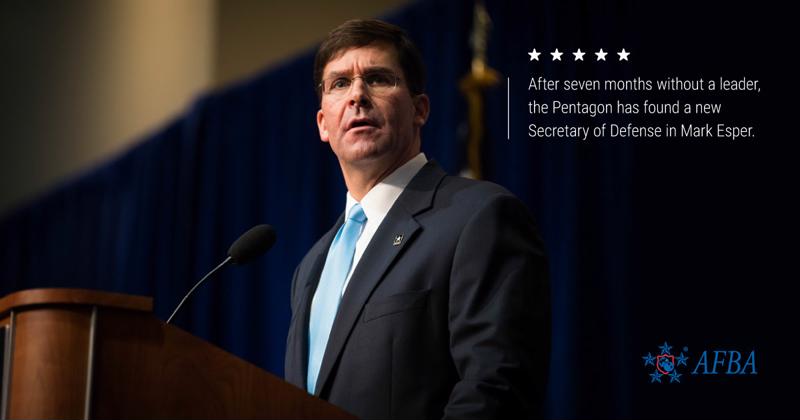

27th Secretary of Defense
Despite some pointed questions from the Senate about his previous lobbying for Raytheon, one of the largest defense contractors, Esper sailed through confirmation on a bipartisan vote of 90-8. That ended the seven-month, record-breaking stretch of DoD operating without a confirmed leader. The lull was created when Jim Mattis stepped down amid apparent policy differences with the Trump Administration. Patrick Shanahan, a former Boeing executive, served as acting secretary but withdrew from the position after complications in his personal life emerged.
Esper succeeded Shanahan in an acting capacity, but as secretary has pledged to maintain U.S. alliances, modernize the military and reform the Pentagon. He also has vowed to continue on the National Defense Strategy path, a strategic plan crafted by Mattis that focuses on long-term competition with China and Russia.
The margin of the vote was notable in for a Trump-appointed official, and was largely seen as reflective of Capitol Hill's desire to return normalcy to DoD with a permanent leader.
"We're in a very great position … in that we have someone that is enthusiastically supported by Republicans, by Democrats, and he is obviously the right person who has the trust of our president, he has the trust of our military, the trust of Congress and the country to keep our nation safe," Senator Jim Inhofe (R-OK), chairman of the Senate Armed Services Committee, said to the Senate in support of Esper, according to Stars and Stripes.
Senator Mitch McConnell (R-KY), Senate Majority Leader, also added praise for the pedigree Esper built with the Army in support of his confirmation as secretary, concluding that his leadership skills would be welcomed at the Pentagon.
"His record of public service is beyond impressive," McConnell said, according to Defense News. "His commitment to serving our service members is beyond obvious. And the need for a Senate-confirmed Secretary of Defense is beyond urgent."
One of the five service branches of the U.S. Armed Forces, the Coast Guard plays a vital role in patrolling the country's coasts and waterways. Now more than two centuries old, the Coast Guard has a storied and rich history in the American military. And while it is the smallest of the five branches, it has an outsized role in advancing and protecting U.S. public, environmental and economic maritime interests.
In recognition of the service the Coast Guard and its members have rendered, every August 4 is celebrated as the Coast Guard's birthday. Now turning 229, one could hardly notice its age, as the Coast Guard continues to become more technologically advanced and responsive to the call of its country.
So on Sunday, Aug. 4, 2019 remember all the Coast Guard has given, and celebrate its continued achievement as the oldest continuous sea-going service in the United States.
10 ships started it all
The Coast Guard's age puts it on par with the Army, which was established even before the Declaration of Independence was signed. The Revenue-Marine were commissioned on Aug. 4, 1790 under the Tariff Act, which was signed by President George Washington. This unit, which would go on to become the Coast Guard, was initially made of 10 ships, and was brought into being with the support of the nation's first Secretary of the Treasury, Alexander Hamilton.
Ten cutters, a type of sea vessel, were created and its crews were tasked with the enforcement of tariff laws, prevention of smuggling and protection of federal tax collectors. Added responsibilities were taken on in short order, including combating piracy, conducting rescue operations and ice-breaking missions, to name a few. These varied law enforcement, military and humanitarian duties serve as the basis for the three mandates of the Coast Guard:
- Safety.
- Security.
- Stewardship.
In time, the Revenue-Marine would expand and grow into the Revenue Cutter Service, and in 1915 was merged with the U.S. Life-Saving Service. The resulting entity was renamed the Coast Guard, and it continued to acquire new responsibilities, like oversight of the country's lighthouses and marine inspection and navigation. Now, the Coast Guard seizes a drug-smuggling boat every five days, saves thousands of lives every year, and assists 193,938 tons of shipping daily during Great Lakes ice season.
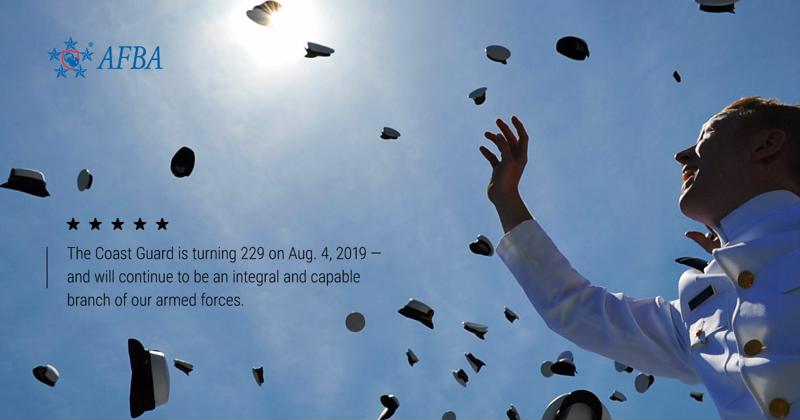

More facts about the Coast Guard
There's a lot to be accomplished in 229 years, and the Coast Guard has done quite a bit, including:
- Serving in 17 wars and conflicts in U.S. history. During wartime the Coast Guard can operate independent mission or serve as part of the Navy.
- Being the only of the five branches to be placed under the Department of Homeland Security.
- Patrolling more than 4.5 million square miles of Exclusive Economic Zones, as well as providing services in international waters.
- Operating its own anti-terror team, The Maritime Safety and Security Team. According to the USO, it is the only special operations force that can arrest submerged SCUBA divers.
- Having Sinbad, a dog that served aboard the USCGC George W. Campbell in World War II, as its mascot. Sinbad provided company to troops, while also being onboard for anti-submarine confict.
How you can celebrate the Coast Guard's birthday
In lieu of trying to send a Happy Birthday card to the Coast Guard itself, take time to recognize and celebrate the service of its members:
- Participate in or organize a local event that can help educate children on the Coast Guard history or hear active duty members or veterans speak.
- Offer a special discount on Aug. 4 if you run a business for Coast Guard members and veterans.
- Visit memorials or other locations to pay respects for the fallen and recognize their sacrifice.
The Coast Guard is turning 229 on Aug. 4, 2019 — and will continue to be in the future an integral and capable branch of our armed forces.


